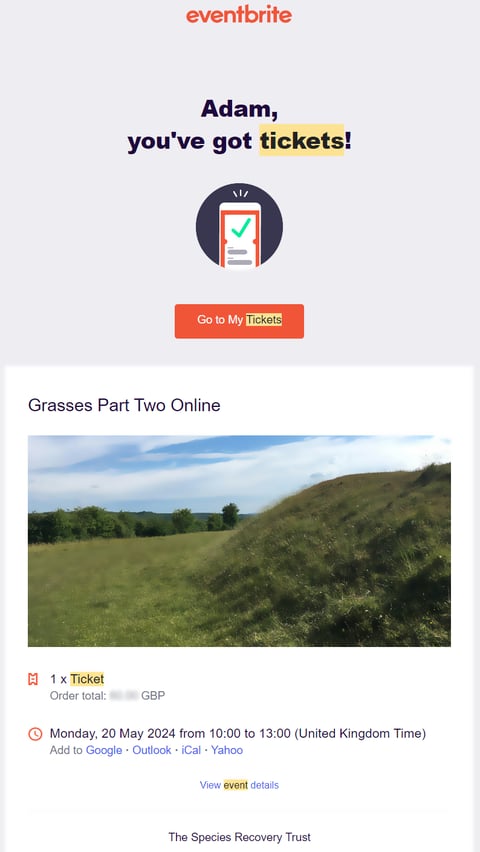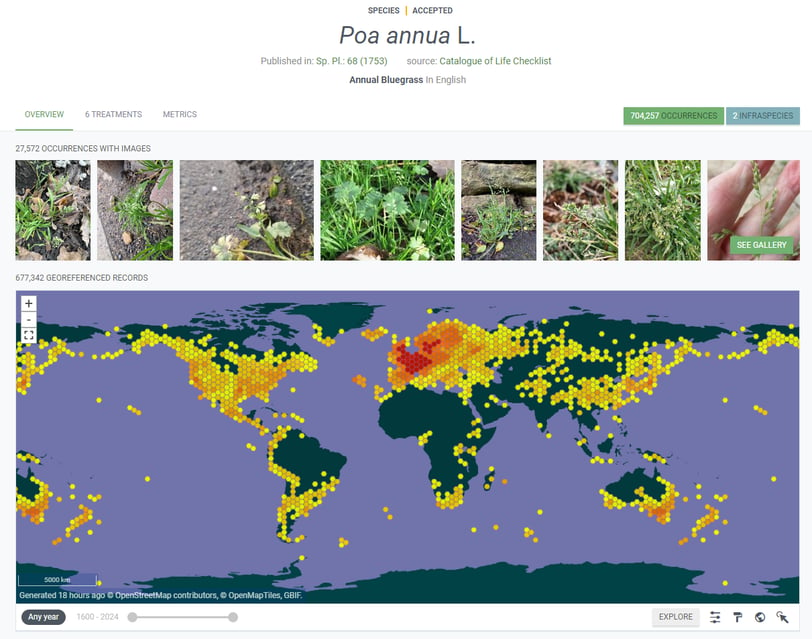Grasses - Part 2
Task 8: Engaging the community
This was an online course provided by The Species Recovery Trust, a charity dedicated to protecting endangered species in the UK (The Species Recovery Trust, 2023). It was delivered by Dominic Price. It provided a follow up to the 'Around Britain in 25 Grasses' course, by covering another 25 species of grass/sedge/rush. It consisted of a video presentation, along with questions to test understanding. My notes are below.
The Species Recovery Trust
Grasses - Part 2
20 May 2024


Species
The following species were grouped by habitat, or similarity, and discussed:
Woods
Hairy Brome
Bromopsis ramosis
Associated with woodland rides/glades.
Large, droopy. Branched inflorescence. Can see hairy stem easily. Looks hairy, feels bristly at bottom of stem.
Wood Millet
Milium effusum
Head looks a little like a poa. Very hard heads. If not in flower, quite hard. More to do with size(height)/weight?
Creeping soft-grass
Holcus mollis
Medium sized, bit droopy on the leaves. Rarely seen in flower. Hairy knees – nodes (but otherwise pretty hairless). Similar inflorescence to Yorkshire fog, but much slenderer.
Wood Meadow-grass
Poa nemoralis
As this is a Poa it has: double groove, boat shaped tip leaves.
Very shiny. No purple base, so not Lolium perenne. Sprawling, very thin leaves. Inflorescence very different to vegetative. Likes a bit of disturbance. Ancient woodland indicator. Looks droughted, sprawling on the ground.
Wood Melic
Melica uniflora
“Quaking grass of the woods”. Often on banks. Quite good growing from low nutrients. Vegetative similar to Creeping soft-grass.
Large Fescues
Giant Fescue
Schedonorus giganteus
(might be listed as Festuca)
Big, glossy, broad leaves. Pointy, whip-like narrow seeds. Very big plant. Has a purple auricle.
Meadow Fescue
Schedonorus pratensis
Strong stems. Very upright. Can’t pull it out. Often higher than other things in the meadow. Tough leaves, stems. Auricle: not hairy or purple. Can hybridize with perennial rye-grass (looks like a cross between the 2).
Tall Fescue
Schedonorus arundinaceus
Bigger grass than others around it. Can’t pull it out of the ground. Weighty flow-head, dense seeds. Coastal small roads, or trackways. Large tussocks. Hairy auricle – sometimes falls off later in the year.
Bromes
Tor-grass
Brachypodium pinnatum
Tough, but leaves not as rigid. Can be problem in chalk-grassland. Often where sheep grazed for a long time. Very yellow, especially early season, upright. Clumps, tussocks, very aggressive.
Soft-brome
Bromus hordeaceus
Very variable height. Sometimes 10 parts of flower heads, sometimes 1! Soft stems, soft leaves, soft heads (and plump). Often on path-sides, likes a bit of disturbance.
False Brome
Brachypodium sylvaticum
Tussock forming. Yellow and droopy. Likes being around scrub. Sheep don’t graze it. In woods not as yellow. A bit hairy, very broad-leaves.
Poa
Annual Meadow-grass
Poa annua
Pioneer of bare/disturbed ground. Can be very short. Small plant. Crinkly leaf is a good diagnostic. Flower structure: 1 sided flower. Other Poas go all the way around.
Most widely distributed plant on the planet! Only plant to be found on every continent.
Rough Meadow-grass
Poa trivialis
Prefers more nutrients, improved grassland. Stem leaf is floppier (than P. pratensis). Ligule is long and rough/raggedy at the top. Rub sheath below leaf feels rough (but not overwhelmingly rough).
Smooth-Meadow-grass
Poa pratensis
Prefers less nutrients. Ligule is short. Rub sheath below leaf feels smooth.
Meadow-grass
Leaves have a groove in the middle (sometimes double tram-line) and are boat shaped leaves. Agrostis has grooves but is more like a corrugated surface.
In flower: Poas flower May/June, Agrostis July/Aug. If it is feathery and a bit clumpy then Poa. If finer, and feathery, then Agrostis.
Damp grasslands and ponds
Meadow Foxtail
Alopecurus pratensis
Likes the damp, but not as much as Marsh Foxtail.
Floating Sweet-grass
Glyceria fluitans
Buoyant, river grass. Also grows on mud, riverbanks. Whip-like stems, very skinny flower head. Look at glume margins, they are pointy and look a little 'fluid'.
Marsh Foxtail
Alopecurus geniculatus
Right angle on the knee, normally flower head is a bit thinner than A. pratensis. Slightly swollen sheath.
Reed Sweet-grass
Glyceria maxima
Very aquatic, very large (2m?). Branched inflorescence.
Purple Moor-grass
Molinia caerulea
Only true deciduous native grass as it sheds leaves. Flowers are quite purple due to anthers. Tussocky. On heaths, mires. Ring of hairs where leaf joins stem. When its young, leaves are quite purple.
Its old leaves are used as a fire trap to burn, as the Molinia survives the fire but not much else does.
Calcareous grasslands (+ others)
Crested Hair-grass
Koeleria macrantha
A bit like Yorkshire-fog. Much whiter and shinier, reflects the light. A bit of a metallic shine in the light. Grooves and hairy.
Smaller Cat’s-tail
Phleum bertolonii
Smaller than 6cm. Base like spring-onion. Vegatively similar to Agrostis.
Yellow Oat-grass
Trisetum flavescens
Ghostly white. Flowerheads look like fireworks, spiky all directions. Difficult to spot when not in flower. Likes calcareous but also in meadows, wide-ranging.
Timothy
Phleum pratense
Improved grassland. Larger than 6cm. Stem is sometimes wiggly below flowerhead. Base is white.
Wall Barley
Hordeum murinum
Strong relationship with ammonia e.g. edge of car park where dogs urinate! Broad leaf, floppy, messy. Huge auricles, sometimes cross over, or dangling down (possibly the largest auricle in this country?). Clumpy flower, barbed.
Meadow Barley
Hordeum secalinum
Slenderer than Wall Barley, grows in meadows.
Reflection
I found this follow up course interesting and feel that after this I have had a good introduction to the most common grasses, sedges and rushes found in this country. There is a lot of information and it will take some practice, but it at least feels possible to identify common grasses!
There were some facts that I found particularly interesting, such as how Purple Moor-grass Molinia caerulea loses its leaves and the old leaves build up to become a fire-trap. A resulting fire will then burn through pretty much everything else, but the Purple Moor-grass can survive to gain a competitive advantage. It was pointed out that this could be one natural way that wooded/scrubby areas can revert back to grasslands.
Also, seeing how successful Annual Meadow-grass Poa annua is, and that it has been found on every continent (including Antarctica) made me appreciate just how adaptable this grass is.


Distribution of Poa annua, as taken from GBIF (GBIF Secretariat, 2023)
References
The Species Recovery Trust (2023) The Species Recovery Trust. Available at: https://www.speciesrecoverytrust.org.uk/ (Accessed: 10 February 2024).
GBIF Secretariat (2023) Poa annua L. Available at: https://www.gbif.org/species/2704179 (Accessed: 03 June 2024).
